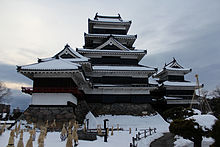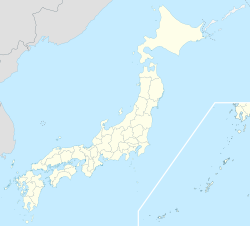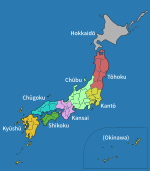Matsumoto Castle
| Matsumoto Castle | |
|---|---|
松本城 | |
| Matsumoto, Nagano Prefecture, Japan | |
 The keep | |
| Coordinates | 36°14′20″N 137°58′09″E / 36.23889°N 137.96917°E |
| Type | Hirashiro (flatland castle) |
| Site information | |
| Condition | Original keep (tenshu) and inner walls survive, several gates have been rebuilt since 1960 |
| Site history | |
| Built | Current structures date from 1594 |
| Built by | Shimadachi Sadanaga |
| In use | 1504 to 1868 |
| Materials | Earth, stone, and wood |
| Demolished | Outer castle was taken down and the land reclaimed in the Meiji Restoration |
Matsumoto Castle (松本城, Matsumoto-jō), originally known as Fukashi Castle, is one of
.The
Matsumoto Castle is a flatland castle 平城 (hirajiro) because it is not built on a hilltop or amid rivers, but on a plain.[1] Its complete defences would have included an extensive system of inter-connecting walls, moats, and gatehouses.[1]
History

The castle's origins go back to the
Takeda Shingen appointed his retainer Baba Nobuharu as castellan. The castle was the Takeda field headquarters for their conquest of the Matsumoto Basin and as a redoubt in the constant conflict between the Takeda and the powerful Uesugi clan to the north. Following the defeat of the Takeda clan by Oda Nobunaga in 1582, the castle was surrendered to Oda Nagamasu. It was soon reassigned to Kiso Yoshimasa.
With the assassination of Oda Nobunaga in 1582, the castle was seized by Ogasawara Dosetsuzai with the backing of Uesugi Kagekatsu. His nephew, Ogasawara Sadayoshi, later pledged fealty to Tokugawa Ieyasu, and renamed the castle "Matsumoto Castle".
Following
During the
Preservation

In 1872, the new
The daimyo residence in the Ni-no-Maru enclosure was also preserved for use as the prefectural office for Chikuma Prefecture. However, it was burned down in an act of arson in 1876, with only a storehouse dating from the end of the Edo period surviving.[4] At the time, Chikuma and Nagano prefectures were about to be merged to form modern-day Nagano Prefecture, and there was a controversy over where to locate the prefectural capital. The loss of this building decided the location in favor of Nagano city, and the Matsumoto District Court was built on the site in 1878.
In the late Meiji period the tenshu started to lean to one side. It was because of neglect coupled with a structural defect, but many people believed the tower leaned due to the curse of Tada Kasuke. He had been caught and executed for attempting to appeal unfair tax laws (Jōkyō uprising).[5] A local high school principal, Kobayashi Unari, decided to renovate the castle and appealed for funds. The castle underwent "the great Meiji renovation" between 1903 and 1913.
The castle was designated a National Historic Site in 1930. The five surviving original structures in the main keep complex ( Tenshu, Inui-ko-tenshu (small northern tower), Watari-yagura (roofed passage), Tatsumi-tsuke-yagura (southern wing), and Tsukimi-yagura (moon-viewing room) ) were designated as
In 1990, the Kuromon-Ninomon (second gate of the Black Gate) and sodebei (side wall) were reconstructed. The square drum gate was reconstructed in 1999.
On April 6, 2006, Matsumoto Castle was selected as one of Japan's Top 100 Castles.[7]
Matsumoto Castle was damaged in a 5.4 magnitude earthquake on June 30, 2011. The quake caused approximately ten cracks in the inner wall of the main tower.[8]
There is a plan for restoring the soto-bori (outer moat), which was reclaimed for a residential zone.[9]
The second floor of the main keep features a gun museum, Teppo Gura, with a collection of guns, armor, and other weapons.[10]
Gallery
-
The Tenshu and Inui Kotenshu
-
The exterior of the castle c.1910
-
Kuromon (Black Gate)
-
Kuromon (Black Gate) different view
-
Inside Matsumoto castle
-
Window for firingbows
-
Matsumoto Castle keep complex as seen from inside the main enclosure.
-
The Inui Kotenshu (left), Tenshu (center) Tatsumi Tsukeyarua (right) and moat.
-
Inui Kotenshu and Tenshu as seen from the bridge.
-
Castle view from the main gate.
-
View of illuminated Matsumoto Castle
See also
- List of National Treasures of Japan (castles)
- List of Historic Sites of Japan (Nagano)
- Tourism in Japan
Literature
- Benesch, Oleg and Ran Zwigenberg (2019). Japan's Castles: Citadels of Modernity in War and Peace. Cambridge: Cambridge University Press. p. 375. ISBN 9781108481946.
- De Lange, William (2021). An Encyclopedia of Japanese Castles. Groningen: Toyo Press. pp. 600 pages. ISBN 978-9492722300.
- Mitchelhill, Jennifer (2013). Castles of the Samurai:Power & Beauty. USA: Kodansha. ISBN 978-1568365121.
- Schmorleitz, Morton S. (1974). Castles in Japan. Tokyo: Charles E. Tuttle Co. ISBN 0-8048-1102-4.
- Motoo, Hinago (1986). Japanese Castles. Tokyo: Kodansha. pp. 200 pages. ISBN 0-87011-766-1.
(In Japanese)
- Nakagawa, Haruo (2005). Zusetsu Kokuhō Matsumoto-Jō (National Treasure, Matsumoto Castle Illustrated).Issōsha Publishing
References
- ^ a b c d "The Three Famous Castles of Japan". Kobayashi Travel Service. Archived from the original on 2010-03-22. Retrieved 2010-07-04.
- ^ https://www.matsumoto-castle.jp/eng/about/tower#:~:text=Designated%20National%20Treasure%20structures%2C%20the,and%20Tsukimi%20Tower%2C
- ^ Matsumoto City Official Website "Matsumoto Castle in History". Archived from the original on 2010-03-24. Retrieved 2009-12-11.
- ^ https://www.mlit.go.jp/tagengo-db/common/001654040.pdf
- ^ "Side Stories of the Uprising". Retrieved 2009-12-11.
- ^ https://www.mlit.go.jp/tagengo-db/common/001654040.pdf
- ^ Japan Castle Foundation (in Japanese)
- ^ "M5.4 quake jolts Nagano Pref., injuring 8". Archived from the original on 2011-06-30. Retrieved 2011-06-30.
- ^ Proposal presented by Matsumoto City (in Japanese)"(3)保存管理計画". Archived from the original on 2009-08-14. Retrieved 2009-12-11.
- ^ http://www.yamasa.org/japan/english/destinations/nagano/matsumotojou.html Archived 2012-07-24 at the Wayback Machine Matsumoto Castle - Yamasa Institute, Japan Travel Guide
External links
![]() Media related to Matsumoto Castle at Wikimedia Commons
Media related to Matsumoto Castle at Wikimedia Commons
- Matsumoto Castle Welcome Guide
- Matsumoto Castle English Guide
- Nagano Official Tourism Website - Matsumoto Castle Archived 2013-10-18 at the Wayback Machine
- [1]- Interactive 3-D Matsumoto Castle by Professor Jon Amakawa of the Art Institute of Pittsburgh.
- [2] Archived 2021-11-16 at the Wayback Machine Photography of Matsumoto Castle from Heso magazine
















